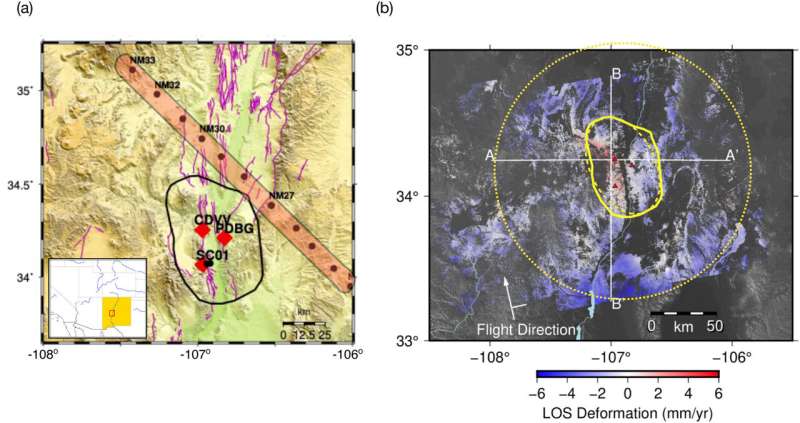
Although volcanoes have been extensively studied, unraveling the mysteries of the underlying magma transport proves to be a challenging pursuit. Grant Block, a graduate student in The University of New Mexico’s Department of Physics & Astronomy, recently conducted a thorough study of the Socorro Magma Body (SMB) in Socorro, N.M., which provides a window into magmatic processes important in volcanic activity (although there is no such activity above the SMB).
Block, along with his Ph.D. advisor Professor Mousumi Roy, collaborated with the University of Alaska at Fairbanks to further the understanding of the SMB. The research titled “Pressurizing Magma Within Heterogeneous Crust: A Case Study at the Socorro Magma Body, New Mexico, U.S.” was recently published in the journal Geophysical Research Letters.
This paper models how magma in the crust is stored within magma bodies (regions that are mostly liquid magma) and “mush” (mostly solid crystals and some liquid magma). Mush zones are thought to be too viscous to be erupted but are likely to be weaker than the surrounding rock.
The purpose of this project was to try to better understand the mechanisms causing the pattern of central uplift and peripheral subsidence, termed “sombrero deformation,” observed at the surface above the SMB. The SMB is a mid-crustal magma body with no magma transport or volcanism above it, which makes it a perfect “laboratory” to study the dynamics of mid-crustal magma bodies in general.
“Furthering our knowledge of mid-crustal magma bodies will help us better understand the full crustal magma transport systems where they sit. It’s these systems that feed every volcanic eruption on Earth, so studying them is crucial,” stated Block.
Specifically, Block and his team were interested in the role of “mush” in these systems. Mush is magma that has crystallized to the point where it’s too viscous to be erupted but is still more deformable than the surrounding rock. It is thought to be important in the dynamics and evolution of magma reservoirs such as the SMB.
Surface deformation at the Socorro Magma Body (SMB) was used in this project to study magma-mush interaction. Previous surface deformation measurements at the SMB show long-lasting “sombrero” deformation.
“Our goal for this project was to use measurements of surface deformation above the SMB to better understand the role of mush in the SMB. This may add to geoscientists’ understanding of crustal magma transport systems as a whole,” said Block.
Block’s research was computational, meaning he developed computer simulations of a simplified SMB system which he ran on UNM’s Center for Research Computing (CARC). The development of these simulations was informed by satellite radar data analyzed by collaborators at the University of Alaska at Fairbanks. Block was able to show that his simulations agreed well with the observed pattern of surface motions from the radar data analyzed by the University of Alaska at Fairbanks.
“This agreement lets us use parameters from my models, such as the geometry and viscosity of a mushy or otherwise compliant region around the SMB, to make predictions about the actual SMB systems (which is very difficult to directly observe). These parameters we found may be further tested in later studies,” said Block.
New satellite radar measurements are consistent with the previously reported pattern, confirming that this deformation remained remarkably constant through nearly 100 years. Block and Roy suggest this is due to a large weak, compliant region surrounding the SMB, which could be mush.
Their computer models reproduce a long-lasting, consistent sombrero deformation pattern dependent on mush properties as well as the pressurization of the magma body, and the authors suggest these factors may explain why this pattern is relatively rare.
The scientists were able to find that their simulations were able to have a good agreement with the data when they have a compliant region of lower viscosity than the background structure surrounding an SMB source pressurized in a periodic, asymmetric manner. This compliant region could be mush or weakened in some other way. This question will be the subject of future work.
“Nobody in New Mexico is under imminent threat of volcanic unrest from the SMB or anything else in the state. However, right under our feet lies an ideal testing ground that will help scientists understand volcanoes around the world. And beyond the SMB, so much of New Mexico’s rich natural landscape and history was shaped by magmatic activity—from Valles Caldera to El Malpais to Bandelier.”
“We live in a state shaped by volcanoes and now our state can play a major role in understanding and keeping people safe from volcanoes. This is something every New Mexican can take pride in,” said Block.
The researchers were able to conclude that a (potentially mushy) compliant region surrounding an asymmetrically pressurizing source is a reasonable approximation for the mechanics of the SMB, verified with ground surface velocity data.
More information:
Grant A. Block et al, Pressurizing Magma Within Heterogeneous Crust: A Case Study at the Socorro Magma Body, New Mexico, USA, Geophysical Research Letters (2023). DOI: 10.1029/2023GL105689
Journal information:
Geophysical Research Letters
Provided by
University of New Mexico
Scientists investigate Socorro Magma Body to enhance volcanic understanding (2023, December 6)
retrieved 7 December 2023
from https://phys.org/news/2023-12-scientists-socorro-magma-body-volcanic.html
part may be reproduced without the written permission. The content is provided for information purposes only.